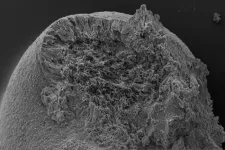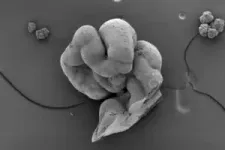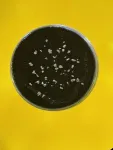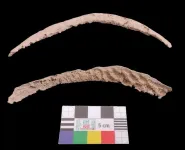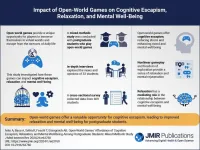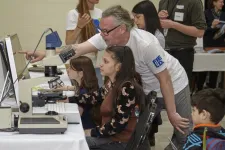(Press-News.org) Scientists at the Francis Crick Institute have generated human stem cell models1 which, for the first time, contain notochord – a tissue in the developing embryo that acts like a navigation system, directing cells where to build the spine and nervous system (the trunk).
The work, published today in Nature, marks a significant step forward in our ability to study how the human body takes shape during early development.
The notochord, a rod-shaped tissue, is a crucial part of the scaffold of the developing body. It is a defining feature of all animals with backbones and plays a critical role in organising the tissue in the developing embryo.
Despite its importance, the complexity of the structure has meant it has been missing in previous lab-grown models of human trunk development.
In this research, the scientists first analysed chicken embryos to understand exactly how the notochord forms naturally. By comparing this with existing published information from mouse and monkey embryos, they established the timing and sequence of the molecular signals needed to create notochord tissue.
With this blueprint, they produced a precise sequence of chemical signals and used this to coax human stem cells into forming a notochord.
The stem cells formed a miniature ‘trunk-like’ structure, which spontaneously elongated to 1-2 millimetres in length. It contained developing neural tissue and bone stem cells, arranged in a pattern that mirrors development in human embryos. This suggested that the notochord was encouraging cells to become the right type of tissue at the right place at the right time.
The scientists believe this work could help to study birth defects affecting the spine and spinal cord. It could also provide insight into conditions affecting the intervertebral discs – the shock-absorbing cushions between vertebrae that develop from the notochord. These discs can cause back pain when they degenerate with age.
James Briscoe, Group Leader of the Developmental Dynamics Laboratory, and senior author of the study, said: “The notochord acts like a GPS for the developing embryo, helping to establish the body’s main axis and guiding the formation of the spine and nervous system. Until now, it’s been difficult to generate this vital tissue in the lab, limiting our ability to study human development and disorders. Now that we’ve created a model which works, this opens doors to study developmental conditions which we’ve been in the dark about.”
Tiago Rito, Postdoctoral Fellow in the Developmental Dynamics Laboratory, and first author of the study, said: “Finding the exact chemical signals to produce notochord was like finding the right recipe. Previous attempts to grow the notochord in the lab may have failed because we didn’t understand the required timing to add the ingredients.
“What’s particularly exciting is that the notochord in our lab-grown structures appears to function similarly to how it would in a developing embryo. It sends out chemical signals that help organise surrounding tissue, just as it would during typical development.”
-ENDS-
For further information, contact: press@crick.ac.uk or +44 (0)20 3796 5252
Notes to Editors
Reference: Rito, Tiago. et al. (2024). Timely TGF-b signalling inhibition induces notochord. Nature. 10.1038/s41586-024-08332-w.
These structures are simplified models of the body which contain only a small number of cell types. They develop for just a few days and cannot form embryos. Their main purpose is for studying aspects of human development that have been difficult or impossible to investigate directly.
The Francis Crick Institute is a biomedical discovery institute dedicated to understanding the fundamental biology underlying health and disease. Its work is helping to understand why disease develops and to translate discoveries into new ways to prevent, diagnose and treat illnesses such as cancer, heart disease, stroke, infections, and neurodegenerative diseases.
An independent organisation, its founding partners are the Medical Research Council (MRC), Cancer Research UK, Wellcome, UCL (University College London), Imperial College London and King’s College London.
The Crick was formed in 2015, and in 2016 it moved into a brand new state-of-the-art building in central London which brings together 1500 scientists and support staff working collaboratively across disciplines, making it the biggest biomedical research facility under a single roof in Europe.
http://crick.ac.uk/
END
In spring 1495, the Italian campaign of Charles VIII of France was interrupted by an intense outbreak of an apparently unknown illness – a disease of high mortality that quickly engulfed the whole of Europe and left its survivors with life changing impairments to their bodies and minds. This documented epidemic is now interpreted to be the first historical account of syphilis.
The origin of syphilis is the subject of a decades-long debate. The late 15th century outbreak occurred shortly after the return of Columbus and his crew from their early expeditions to the Americas, which led some to believe that ...
About The Study: In this cohort of 1,500 children, across demographic subgroups, the trajectory of cardiovascular health (CVH) scores began to decline at approximately age 10, associated with health behaviors rather than health factors. Statistically significant (albeit small) differences in CVH trajectory parameters by sociodemographic characteristics were also identified. This study provides insight into the trajectory of CVH early in life, which may contribute to CVH disparities in adulthood, and identified modifiable ...
About The Study: This study found that Black children and adolescents were suspected to have experienced child abuse at higher rates than children and adolescents of other racial and ethnic backgrounds. More research is necessary to understand the origins of these disparities to reduce them in child abuse identification.
Corresponding Author: To contact the corresponding author, Norah E. Liang, MD, email nliang@stanford.edu.
To access the embargoed study: Visit our For The Media website ...
Key Takeaways:
A new study led by the Harvard Pilgrim Health Care Institute sheds light on the trajectory of cardiovascular health (CVH) early in life, which may contribute to CVH disparities in adulthood.
Across demographic subgroups, CVH scores begin to decline at approximately 10 years of age and appear driven by health behaviors rather than health factors.
Key health behaviors to target for improving early-life CVH include better sleep, healthier diet, and reducing smoking.
Boston, MA — Cardiovascular ...
Ludwig van Beethoven began to lose his hearing at age 28 and was deaf by age 44. While the cause of his hearing loss remains a topic of scientific debate and ongoing revision, one thing is clear: Despite his hearing loss, Beethoven never ceased to compose music, likely because he was able to sense the vibrations of musical instruments and “hear” music through the sense of touch, researchers believe.
Now a study by Harvard Medical School researchers could help explain what enabled Beethoven, ...
We are thrilled to announce that our esteemed academic journal, iEnergy, has been officially included in the Emerging Sources Citation Index (ESCI) by Web of Science, a leading global provider of scientific and scholarly research information. All articles published by iEnergy since its establishment in 2022 will be included in ESCI. And it will receive the first impact factor in 2025.
About iEnergy:
iEnergy is a quarterly journal launched on March 2022. It has published 3 volumes (11 issues), in total 124 papers. Authors come from 21 countries, including ...
In the midst of the ongoing global biodiversity crisis, even the smallest habitats like ponds demand our attention. Fragmentation of these habitats—driven by human activities like urbanization, agriculture, and land-use changes—poses a significant threat to biodiversity. Often overlooked in conservation efforts, ponds serve as vital ecological hotspots, supporting diverse species and sustaining essential ecosystem processes. These waterbodies are home to various microbial communities that, despite their tiny size play an indispensable role in ecosystem functioning, acting ...
(Toronto, December 18, 2024) A study published in the Journal of Medical Internet Research has found that open-world video games can significantly improve relaxation and mental well-being among postgraduate students. Open-world games, known for their expansive environments and player autonomy, offer a form of cognitive escapism that helps players disconnect from daily stressors and enhance their mood.
The study, a collaboration between researchers from Imperial College London, United Kingdom, and the University of Graz, Austria, used a mixed methods approach: they combined survey data from 609 players and in-depth interviews of 32 players. Popular titles like The ...
A study of more than 26,000 white dwarf stars has confirmed a long-predicted but elusive effect in these ultra-dense, dying stars: Hotter white dwarfs are slightly puffier than cooler ones, even when they have the same mass.
The findings bring scientists one step closer to using these stellar objects as natural laboratories to probe the effects of extreme gravity and hunt for exotic dark matter particles. Details about the research, led by Johns Hopkins University, are published in The Astrophysical Journal.
“White dwarfs are one of the best characterized stars that we can work with ...
There are over three billion specimens and cultural objects housed in natural history collections around the world—things like fossils, dried plants, and pinned insects. Close to forty million of them are at the Field Museum in Chicago, mostly behind the scenes in a vast library documenting life on Earth. These collections are used by scientists at the museum and around the world to explore what lived where and when and how living things have changed over time.
However, much of the information about these collections is hard to access, ...
